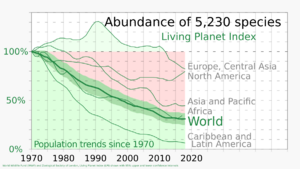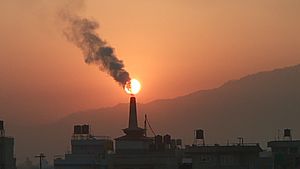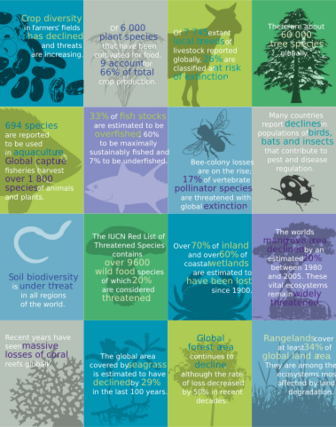Biodiversity loss facts for kids
Biodiversity loss happens when different kinds of plants and animals completely disappear from Earth (this is called extinction). It also means a big drop in the number of species in a certain area. When biodiversity decreases, it means there are fewer different types of living things. This can be a temporary problem if the damage can be fixed, like through ecological restoration. But if the damage is too great, the loss is permanent.
Most biodiversity loss is caused by human activities. We often push our planet's limits too far. This includes destroying natural homes (like cutting down forests) and using land very intensely (like growing only one type of crop). Other big problems are air and water pollution, over-exploitation (using too much of something), new species that don't belong, and climate change.
Many scientists, including those from the Global Assessment Report on Biodiversity and Ecosystem Services, believe that a growing human population is a main reason for biodiversity loss. This is because more people often mean more consumption. However, others argue that habitat loss is mostly due to growing demand for goods to export, and that population size has less to do with overall consumption. They say differences in wealth between countries are more important.
Climate change is another big threat to life on Earth. For example, coral reefs, which are homes for many different species, could be lost by 2100 if global warming continues. But right now, destroying habitats (often for farming) is a bigger problem than climate change for biodiversity loss. New species and other problems have become more common in forests. These are often linked to climate change and can harm forest ecosystems.
Environmental groups have worked for years to stop this loss. Many global plans now include ways to protect biodiversity. For example, the UN Convention on Biological Diversity tries to stop biodiversity loss and protect wilderness areas. But a 2020 United Nations Environment Programme report found that most of these efforts didn't meet their goals. For instance, out of 20 biodiversity goals set in 2010, only six were partly achieved by 2020.
This ongoing worldwide extinction is sometimes called the holocene extinction or the sixth mass extinction.
Contents
- How Many Species Are We Losing?
- How Scientists Measure Loss
- What's Happening to Different Life Forms?
- Why Are Species Disappearing?
- What Happens When Biodiversity Is Lost?
- What Can We Do?
- Images for kids
- See also
How Many Species Are We Losing?
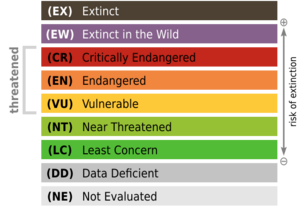
The current rate of species loss is thought to be 100 to 1000 times faster than what would happen naturally. This is quicker than at any other time in human history. Scientists expect it to get even worse. The rapid decline of animals like mammals, birds, reptiles, amphibians, and fish shows a major biodiversity crisis in both land and ocean environments.
In 2006, many more species were officially listed as rare, endangered, or threatened. Scientists believe millions more species are at risk but haven't been officially recognized yet.
Cutting down forests also plays a huge role in losing biodiversity. More than half of the world's biodiversity lives in tropical rainforests. Areas losing a lot of biodiversity are called biodiversity hotspots. Since 1988, these hotspots have grown from 10 to 34. In 2006, 16 of these 34 hotspots were in tropical regions. Even though hotspots cover only 2.3% of the world, they are home to a large part (50%) of vascular plant species.
In 2021, about 28% of the 134,400 species checked by the IUCN Red List were threatened with extinction. That's 37,400 species, compared to 16,119 in 2006.
A 2022 study asked over 3,000 experts. They found that "global biodiversity loss and its impacts may be greater than previously thought." They estimated that about 30% of species "have been globally threatened or driven extinct since the year 1500."
Research in 2023 looked at 70,000 species. It found that about 48% are seeing their populations shrink due to human activities. Only 3% are seeing their populations grow.
How Scientists Measure Loss
Scientists define biodiversity as all the genes, species, and ecosystems in a region. To measure how fast biodiversity is being lost, scientists record the number of different species in an area. They also look at how this number changes over time. In ecology, local abundance is how many individuals of a species are in a certain ecosystem. Scientists count how many individuals they find in a sample. The comparison of how many of one species there are compared to others is called relative species abundance. Both of these numbers help scientists figure out biodiversity.
What's Happening to Different Life Forms?
Wildlife in General
A 2020 study by Swiss Re found that one-fifth of all countries are at risk of their ecosystems collapsing. This is due to human-caused habitat destruction and more wildlife loss. If these losses continue, entire ecosystems could collapse.
In 2022, the World Wildlife Fund reported a big drop in animal populations. On average, populations of 4,400 animal species worldwide fell by 68% between 1970 and 2016.
Insects
Insect populations are declining in many places around the world. This is a big concern because insects are vital for ecosystems. They help pollinate plants, break down waste, and are food for many other animals.
Earthworms
Scientists have studied the loss of earthworms in farm fields. They found that earthworm numbers have dropped by 50–100%, with an average drop of 83%. This is similar to losses seen in other animal groups. Earthworms are very important for healthy soil, water, and even balancing greenhouse gases.
There are five main reasons for the decline of earthworms:
- soil degradation and losing their homes
- climate change
- too much pollution from nutrients and other things
- using soil in ways that are not sustainable
- invasive species
Farming methods like tilling and intense land use harm the soil and plant roots that earthworms need. This affects how carbon and nitrogen move through the environment. We don't know much about all the different kinds of earthworms. Less than half of them have been described. Sustainable agriculture methods, like less tilling, could help protect earthworm diversity. The Convention on Biological Diversity is working to restore and protect earthworm species.
Amphibians
Amphibians, like frogs and salamanders, are facing a global crisis. Many species are disappearing at an alarming rate. This is due to habitat loss, pollution, diseases, and climate change.
Wild Mammals
Wild mammal populations are also declining worldwide. This includes many large animals that play important roles in their ecosystems. Their decline is often linked to habitat loss and human activities.
Birds
Pesticides, especially insecticides, likely reduce populations of certain bird species. A study funded by BirdLife International found that 51 bird species are critically endangered. Eight more could be extinct or very close to it. Nearly 30% of bird extinctions are due to hunting and trapping for the exotic pet trade. Deforestation, caused by logging and farming, is another big threat. Birds lose their homes and food sources.
Plants
Plants are essential for human survival, but they haven't received as much attention as animals. It's estimated that one-third of all land plant species are at risk of extinction. Also, 94% of them haven't even been checked to see if they are endangered. Plants are at the bottom of the food chain, so protecting them is crucial to protect all life above them.
Trees
In 2022, scientists warned that one-third of tree species are threatened with extinction. This will greatly change the world's ecosystems. It will affect how carbon, water, and nutrients move through nature. Forest areas are being damaged by logging, fires, and collecting firewood. The Global Tree Assessment found that "17,510 (29.9%) tree species are considered threatened with extinction." Also, 142 tree species are already extinct or extinct in the wild.
Some forest management methods can help. These include selective logging, thinning trees, or managing specific crop trees. Clearcutting and coppicing are other methods. Without solutions, it can take 50 years for secondary forests to regain the same number of species as a primary forest. Or 20 years to get back 80% of their species.
Flowering Plants
Flowering plants are a huge part of Earth's biodiversity. They provide food, medicine, and beauty. However, many flowering plant species are threatened by habitat loss, pollution, and climate change. Protecting these plants is important for the health of entire ecosystems.
Freshwater Species
Freshwater ecosystems like swamps, deltas, and rivers cover only 1% of Earth's surface. But they are home to about one-third of all vertebrate species. Freshwater species are disappearing twice as fast as species on land or in the ocean. This rapid loss has already put 27% of 29,500 species that depend on fresh water on the IUCN Red List.
Global populations of freshwater fish are collapsing due to water pollution and overfishing. Migratory fish populations have dropped by 76% since 1970. Large "megafish" populations have fallen by 94%, with 16 species declared extinct in 2020.
Marine Species
Marine biodiversity includes all living things in the ocean or in estuaries. By 2018, about 240,000 marine species had been recorded. But many more marine species (perhaps millions) have not yet been described. This means that some rare species might disappear without us even knowing.
Human activities greatly harm marine biodiversity. The main reasons for marine species extinction are losing their homes, pollution, invasive species, and overexploitation. Areas near coasts face more pressure because of human settlements there.
Over-exploitation has caused over 25 marine species to go extinct. This includes seabirds, marine mammals, algae, and fish. Examples of extinct marine species are Steller's sea cow and the Caribbean monk seal. Not all extinctions are caused by humans. For example, in the 1930s, the eelgrass limpet became extinct in the Atlantic. This happened when the Zostera marina seagrass population died from a disease. The limpet depended entirely on this seagrass for its home.
Why Are Species Disappearing?
The main reasons for current biodiversity loss are:
- Habitat loss, breaking up habitats, and damaging them. For example, dividing habitats for farms (especially growing only one crop).
- Intense land use (which leads to losing land and habitats). This greatly reduces natural services and biodiversity.
- Nutrient pollution and other types of pollution (like air and water pollution).
- Over-exploitation and using resources unsustainably (like unsustainable fishing methods, overfishing, using too much, and human overpopulation).
- New species that take over and replace native ones.
- Climate change (which causes extinction risks and affects plant biodiversity).
Scientists have used different ways to remember these causes. One idea is the "Evil Quartet": habitat destruction, overhunting, introduced species, and other extinctions that follow. Another is the acronym HIPPO: Habitat destruction, Invasive species, Pollution, human over-Population, and Over-harvesting.
Destroying Habitats
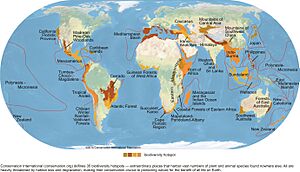
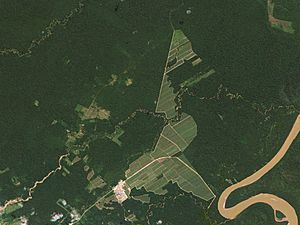
Destroying habitats is a major cause of species decline. For example, it's one reason why insect populations are shrinking.
Cities Growing and Habitats Breaking Apart
When cities grow, they directly cause habitat loss. Building new structures often destroys and breaks up natural homes. This favors species that can adapt to city life. Small pieces of habitat cannot support as many different genes or species as they used to. Some sensitive species might even disappear from these areas. The number of species goes down because their habitat is smaller and broken up. This makes species more isolated and forces them to live on the edges of habitats or find food elsewhere.
Building Infrastructure in important biodiversity areas is a big reason for species loss. Infrastructure is found in about 80% of these key areas. It leads to natural habitats being changed and broken up, causing pollution and disturbance. Animals can also be directly harmed by collisions with vehicles and buildings. These impacts can spread beyond the construction site.
Intense Land Use
Humans are changing how land is used in many ways, and each can lead to habitat destruction and biodiversity loss. The 2019 Global Assessment Report on Biodiversity and Ecosystem Services found that industrial farming is the main reason for biodiversity collapse. The UN's Global Biodiversity Outlook 2014 estimated that 70% of the expected loss of land biodiversity is caused by farming. A 2005 report said that "Cultivated systems [...] cover 24% of Earth's surface." This means areas where at least 30% of the land is used for crops, shifting farming, livestock, or freshwater fish farming in any given year.
More than 17,000 species are at risk of losing their homes by 2050 as farming continues to expand to feed more people. If the world shifted towards mostly plant-based diets, it would free up land. This land could then be used to restore ecosystems and biodiversity. In the 2010s, over 80% of all global farmland was used to raise animals.
As of 2022, 44% of Earth's land area needed conservation attention. This could mean creating protected areas and following land-use policies.
Pollution from Nutrients and Other Things
Air Pollution
Air pollution harms biodiversity. Pollutants are released into the air when we burn fossil fuels and biomass. Industrial and farming activities release pollutants like sulfur dioxide and nitrogen oxides. Once in the air, these can mix with cloud droplets, raindrops, or snowflakes. They form sulfuric acid and nitric acid. When these acids mix with water, they fall as acid rain.
A 2009 study looked at four air pollutants (sulfur, nitrogen, ozone, and mercury) and different ecosystems. Air pollution affects how land and water ecosystems work and their biodiversity. For example, "air pollution causes or helps acidify lakes, eutrophication of estuaries and coastal waters, and mercury buildup in aquatic food chains."
Noise Pollution
Noise from traffic, ships, vehicles, and aircraft can affect how wildlife species survive. This noise can even reach quiet habitats. Noise pollution is common in ocean ecosystems, affecting at least 55 marine species. One study found that as seismic noises and naval sonar increase in marine ecosystems, the variety of cetaceans (like whales and dolphins) decreases. Many studies have shown fewer fish, such as cod and herring, in noisy areas. Catch rates have dropped by 40–80%.
Noise pollution has also changed bird communities and their diversity. Noise can reduce how well birds reproduce, shrink their nesting areas, increase their stress, and reduce the number of species. Noise pollution can also change where prey species live and how many there are, which then affects predator populations.
Pollution from Fossil Fuel Extraction
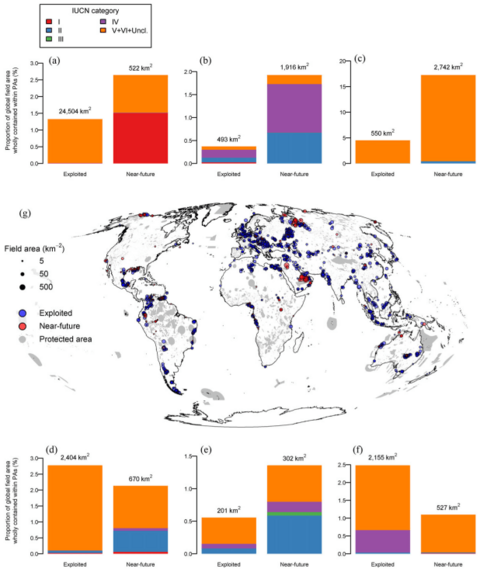
Taking out fossil fuels and building oil and gas pipelines greatly affects the biodiversity of many natural areas. This is due to changing land use, habitat loss and damage, and pollution. The Western Amazon rainforest is an example. Using fossil fuels there has had a big impact on biodiversity. As of 2018, many protected areas with rich biodiversity were in places with untouched fossil fuel reserves worth trillions of dollars. These protected areas might be at risk in the future.
Using Too Much (Overexploitation)
Overexploitation means using a natural resource so much that it can't recover. This can destroy the resource. This term applies to natural resources like water underground, grazing lands, forests, wild medicinal plants, fish stocks, and other wildlife.
Overfishing

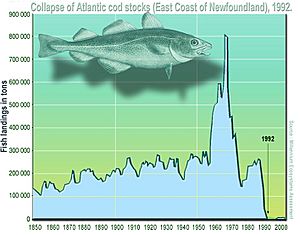
A 2019 report by the Intergovernmental Science-Policy Platform on Biodiversity and Ecosystem Services found that overfishing is the main reason for mass species extinction in oceans. Overfishing has reduced fish and marine mammal numbers by 60% since the 1800s. It is currently pushing over one-third of sharks and rays towards extinction.
Many fish caught for food have been overharvested. A 2020 FAO report said that 34% of the world's marine fish stocks were overfished. By 2020, global fish populations had dropped by 38% since 1970.
There are many rules to control overfishing. These include fishing quotas, bag limits (how many fish you can catch), licenses, closed seasons (times when you can't fish), size limits, and creating marine reserves and other protected ocean areas.
Too Many People and Too Much Consumption
The world's population was almost 7.6 billion in mid-2017. It is expected to reach 10–12 billion people by the end of the 21st century. Experts have argued that population size and growth, along with overconsumption, are big reasons for biodiversity loss and soil damage. Reports, including the 2019 IPBES report, have also noted that human population growth and overconsumption are major drivers of species decline. A 2022 study warned that conservation efforts will keep failing if the main causes of biodiversity loss, including population size and growth, are ignored.
Other scientists disagree that population growth is a key reason for biodiversity loss. They argue that the main reason is habitat loss, caused by "the growth of goods for export." This includes things like soybeans and palm oil, mainly for animal feed or biofuel in richer countries. Because of wealth differences between countries, there's a negative link between a country's total population and how much it consumes per person. However, there's a strong link between a country's wealth (GDP) and its consumption. This study argues that focusing on population isn't helpful for solving environmental problems.
Invasive Species
An invasive species is a plant or animal that is not naturally found in an area but threatens the local biological diversity. These invasions are considered one of the top five reasons for global biodiversity loss. They are increasing because of tourism and globalization. This is especially true in poorly regulated fresh water systems. However, quarantines and ballast water rules (for ships) have helped improve the situation.
Invasive species can cause native species to go extinct. They do this by competing for resources, taking over their roles, or mixing with native species. So, new invasions can greatly change the structure, makeup, and global distribution of life in the places they are introduced. This leads to the world's plants and animals becoming more similar, and a loss of biodiversity.
Climate Change
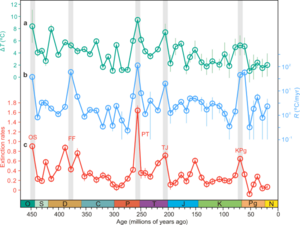
Climate change is another threat to global biodiversity. But destroying habitats, for example, to expand farming, is currently a bigger reason for biodiversity loss.
A 2021 report by scientists from the IPBES and the IPCC found that biodiversity loss and climate change must be dealt with together. They are closely linked and affect human well-being in similar ways. In 2022, Frans Timmermans, Vice-President of the European Commission, said that people are less aware of the threat of biodiversity loss than they are of climate change.
The connection between climate change and invasive species is complex and hard to figure out. Climate change will likely help some invasive species and harm others. But few studies have clearly identified specific results of climate change for invasive species.
Invasive species and other problems have become more common in forests in recent decades. These are often directly or indirectly linked to climate change and harm forest ecosystems.
Risks of Extinction
Climate change is expected to cause many species to go extinct. As temperatures rise, many plants and animals will struggle to adapt. Some may not be able to move to cooler areas fast enough. This could lead to a large number of extinctions, especially for species that are already vulnerable.
What Happens When Biodiversity Is Lost?
Impacts on Ecosystems
Losing biodiversity has bad effects on how ecosystems work. This then affects humans. Damaged ecosystems can no longer provide the same quality of services. These services include helping crops grow (pollination), cleaning air and water, breaking down waste, providing forest products, and offering places for recreation and tourism.
A 2012 review of 20 years of research made two key points:
- "There is now clear proof that losing biodiversity makes it harder for ecological communities to get essential resources, produce living matter, and recycle important nutrients."
- "The effects of diversity loss on ecological processes might be big enough to compete with the impacts of many other global environmental changes."
Permanent global species loss (extinction) is more dramatic than just regional changes in species. But even small changes from a healthy state can greatly affect the food web and food chain. A drop in one species can harm the entire chain, leading to other extinctions. This can cause an overall reduction in biodiversity.
For example, a study on grasslands found that ecosystems with more biodiversity were better at resisting extreme weather events.
Impacts on Food and Farming
In 2019, the UN's Food and Agriculture Organization (FAO) released its first report on The State of the World's Biodiversity for Food and Agriculture. It warned that "Many key parts of biodiversity for food and agriculture at the genetic, species, and ecosystem levels are declining."
The report also said, "Many of the things that harm biodiversity for food and agriculture, including using too much, pollution, too many external inputs, and changes in land and water management, are at least partly caused by wrong farming practices." It added that "moving to intense production of fewer species, breeds, and varieties remains a major reason for losing biodiversity for food and agriculture and ecosystem services."
To reduce biodiversity loss from farming, FAO encourages using "biodiversity-friendly management practices in crop and livestock production, forestry, fisheries, and aquaculture."
Impacts on Health and Medicines
The WHO has looked at how biodiversity and human health are connected. "Biodiversity and human health, and their related policies and activities, are linked in many ways. First, biodiversity provides health benefits. For example, the variety of species and genes provides nutrients and medicines." The ongoing causes and effects of biodiversity loss could lead to future diseases that spread from animals to humans, like the COVID-19 pandemic.
Medicinal and aromatic plants are widely used in traditional medicine, as well as in cosmetic and food industries. The WHO estimated in 2015 that about "60,000 species are used for their medicinal, nutritional, and aromatic properties." There is a global trade in plants for medicinal purposes.
Biodiversity helps in developing pharmaceuticals. A large part of medicines come from natural products, either directly or indirectly. Many of these natural products come from ocean ecosystems. However, unregulated and improper over-harvesting (called bioprospecting) could lead to using too much, damaging ecosystems, and losing biodiversity. People who use and trade plants for traditional medicine either plant them or collect them from the wild. In both cases, managing medicinal resources sustainably is important.
What Can We Do?

Scientists are looking into how to deal with biodiversity loss and climate change together. For both problems, we need to "conserve enough nature and in the right places." A 2020 study found that "beyond the 15% land area currently protected, 35% of land area is needed to conserve more important biodiversity sites and stabilize the climate."
Other actions to protect biodiversity, beyond just environmental protection, are important. These include dealing with the reasons for land use change, making farming more efficient, and reducing the need for animal farming. The last one could be achieved by eating more plant-based diets.
The Convention on Biological Diversity
Many governments have protected parts of their land under the Convention on Biological Diversity (CBD). This is a global agreement signed in 1992–93. The 20 Aichi Biodiversity Targets are part of the CBD's Strategic Plan 2011–2020 and were published in 2010. Aichi Target Number 11 aimed to protect 17% of land and inland water areas and 10% of coastal and marine areas by 2020.
Out of the 20 biodiversity goals set by the Aichi Biodiversity Targets in 2010, only six were partially achieved by 2020. The 2020 CBD report highlighted that if things don't change, biodiversity will keep declining. This is due to "currently unsustainable ways of producing and consuming, population growth, and new technologies." The report also pointed out Australia, Brazil, Cameroon, and the Galapagos Islands (Ecuador) for having lost one of their animals to extinction in the previous ten years.
After this, leaders from 64 nations and the European Union promised to stop environmental degradation and restore nature. Leaders from some of the world's biggest polluters, like China, India, Russia, Brazil, and the United States, did not sign the pledge. Some experts say that the United States' refusal to agree to the Convention on Biological Diversity is harming global efforts to stop the extinction crisis.
Scientists say that even if the 2020 targets had been met, it likely wouldn't have greatly reduced extinction rates. Others worry that the Convention on Biological Diversity doesn't go far enough. They argue the goal should be zero extinctions by 2050, along with cutting the impact of unsustainable food production on nature by half. The fact that the targets are not legally binding has also been criticized.
In December 2022, almost every country signed the Kunming-Montreal Global Biodiversity Framework at the 2022 United Nations Biodiversity Conference. This plan calls for protecting 30% of land and oceans by 2030 (called 30 by 30). It also has 22 other goals to reduce biodiversity loss. When the agreement was signed, only 17% of land and 10% of ocean territory were protected. The agreement includes protecting the rights of Indigenous peoples and changing current subsidies to be better for biodiversity. However, it takes a step backward in protecting species from extinction compared to the Aichi Targets. Critics said the agreement doesn't do enough to protect biodiversity and that the process was rushed.
Other Global and National Actions
In 2019, the Intergovernmental Science-Policy Platform on Biodiversity and Ecosystem Services (IPBES) published the Global Assessment Report on Biodiversity and Ecosystem Services. This report stated that up to a million plant and animal species are facing extinction because of human activity. The IPBES is a global organization similar to the Intergovernmental Panel on Climate Change (IPCC). But it focuses on biodiversity and ecosystem services, not climate change.
The United Nations' Sustainable Development Goal 15 (SDG 15), "Life on Land," includes biodiversity goals. Its fifth goal is: "Take urgent and significant action to reduce the degradation of natural habitats, halt the loss of biodiversity and, by 2020, protect and prevent the extinction of threatened species." This goal has one way to measure progress: the Red List Index.
Nearly three-quarters of bird species, two-thirds of mammals, and more than half of hard corals have been recorded at World Heritage Sites. This is true even though these sites cover less than 1% of the planet. Countries with World Heritage Sites can include them in their national biodiversity plans.
Images for kids
See also
- Biodiversity offsetting
- Defaunation
- Ecological collapse
- Ecological extinction
- Species reintroduction
- Triple planetary crisis



